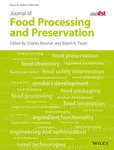Effect of defatted soy and peanut flour obtained by new aqueous method on quality of gluten-free cookies
Abstract
Gluten-free cookies (GFCs) are promoted for avoiding gluten-related celiac disease. Requirement of protein/lysine enhancement in rice GFCs encouraged this study. Partly substituting rice flour by defatted peanut (DPF) or soy (DSF) and their mixture (1 + 1) significantly increased protein/lysine content in GFCs. DSF had the most effect of increasing lysine content. Adding DPF or DSF and their mixture significantly improved GFC hardness and hedonic score. The hedonic score of overall acceptability, taste, crispiness, texture/grain, flavor, and appearance/color of all cookies studied were within very-like scale. Adding DPF or DSF or their mixture produced GFCs with deeper/darker color while DSF had the greatest effect. DPF or DSF or their mixture had dosage-dependent effect of increasing GFC antioxidant capacity while DSF had the greatest effect. DPF, DSF, or defatted peanut and soy flour mixture was also good ingredient to make gluten-free and sugar-free cookies sweetened by meso-erythritol blended with stevia glycosides.
Practical applications
The finding of this study provided scientific data supporting nutritional or other functional fortification by using defatted peanut or soy flours during commercial production of gluten-free cookies. The finding also indicated that new aqueous method can produce defatted peanut or soy flour with good quality suitable for fortifying gluten-free cookies.
CONFLICT OF INTEREST
The authors have declared no conflicts of interest for this article.
Author Contributions
Siqi Wang: conceptualization; ataCuration; formalAnalysis; investigation; visualization. Wenbiao Wu: Conceptualization, Data curation, Methodology, Project administration, Resources, Software, Supervision, Validation, Visualization, Writing – original draft, Writing – review & editing.
Open Research
DATA AVAILABILITY STATEMENT
Data available on request from the authors.




